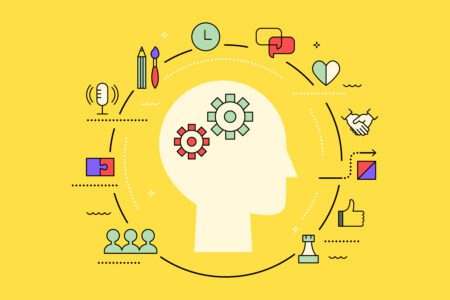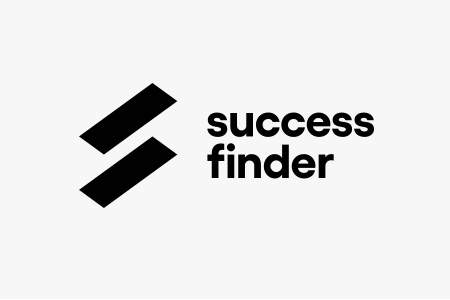An exploration of the Fuller method and Pamela Fuller’s book: The Leader’s Guide to Unconscious Bias.
Biases are part of every human being
A bias is a preference for a type of person, thing, activity, etc. It is to knowingly and openly, or even unconsciously, holding a prejudice or a preconceived idea.
All human beings have biases. Leaders are no exception.
To pretend otherwise means that our brains are malfunctioning, or that we simply don’t understand. Admitting that we have unconscious biases (even if too ugly to admit openly) is more correct.
Identifying unconscious bias
It all begins with knowing ourselves. It is impossible to identify what motivates our decisions and actions if we don’t take a step back and give ourselves time to think.
And let’s face it, taking the time to think things over can be harder than it looks. Especially because when we take the time to lift the carpet and look under it, we may not like what we see.
In her webinar on Unconscious Bias, Pamela Fuller talks about the things she learned about herself that truly surprised her. After having interviewed a very competent candidate, she hired her without hesitation. Later on, the candidate happily informed her that she was pregnant. Fuller was annoyed, thinking of all the inconvenience this news would cause the company.
But as a woman, mother, HR professional and also a thought leader in the sphere of diversity and inclusion in business, why was she not thrilled?
With a little introspection, she came to consider her own frustrations. The fact that she herself did not have access to parental leave contributed to her negative reaction.
As leaders, our reactions have an impact on our team, and our organization. This is why relearning what you thought you knew is all the more important (growth mindset, does that ring a bell?).
Our brain is designed to change according to the information it absorbs. This is called brain plasticity.
The idea of the fixed mindset, whereby our brain stops learning after a certain point because it can only hold a certain amount of information, is not only out-of-date, but simply wrong.
What is true, however, is that our biases are hard to eliminate, because they have been anchored in us from childhood.
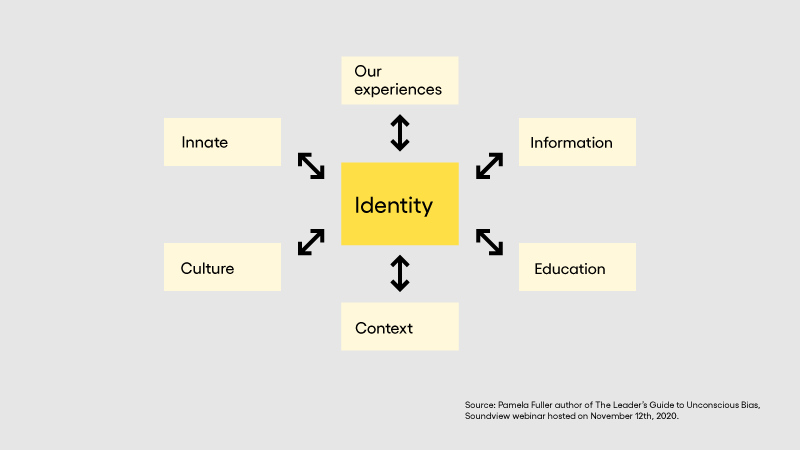
Our identity, just like our biases, comes from our experiences, our education, the context in which we grew up, our culture, etc.
They affect our behavior and our perception of ourselves.
For example, in the context of a leadership meeting, a woman feeling fear of appearing overly emotional or bossy may have a tendency not to say much, and to limit herself to taking notes.
Our biases also affect how we treat others. In her webinar, Pamela brings up the example of one of her colleagues, who, every time she mentioned “an ambitious woman”, did so in a whisper. Through her experiences, her culture, her education, etc., Pamela’s colleague had come to perceive the woman/ambition combo as necessarily negative. For her, an ambitious woman demonstrated a questionable ethical sense, in particular by belittling her peers in order to advance her career.
When we see these kinds of perceptions in our own worlds, the importance of taking a step back to get to know ourselves makes more and more sense.
Take a step back to prevent falling into bias traps
Pamela suggests turning our attention to the Bias Traps. Here are the times when we are most vulnerable to biased decision making:
- Trap 1: When faced with too much information flow
We cover it in our first article of this series on bias: when our brain is bombarded with information, it filters. Although the brain is an incredible machine, it is not flawless. At times, useful and important information for objective decision making passes under the radar.
- Trap 2: When feelings take precedence over facts
When a situation is dear to us, or touches one of our sensitive chords, our beliefs will tend to prevail over the examination of the facts. Using logic to resolve a thorny situation is often a more objective method.
- Trap 3: When you need to go fast, fast, fast!
When we have to meet tight deadlines, stress mounts. In our desire to go faster, our brains tend to take shortcuts. These resulting shortcuts can turn out to be simplistic, selfish and counterproductive.
Measuring the impact of our behaviors on our team
Now that we know the traps during decision-making, we can move on to a more concrete approach to assess the impact of our behaviors on our team.
This is where the heavy lifting of the mind begins and this is the step that I personally found the most difficult. It requires transparency and honesty towards the perceptions and behaviors shown towards your team in the past.
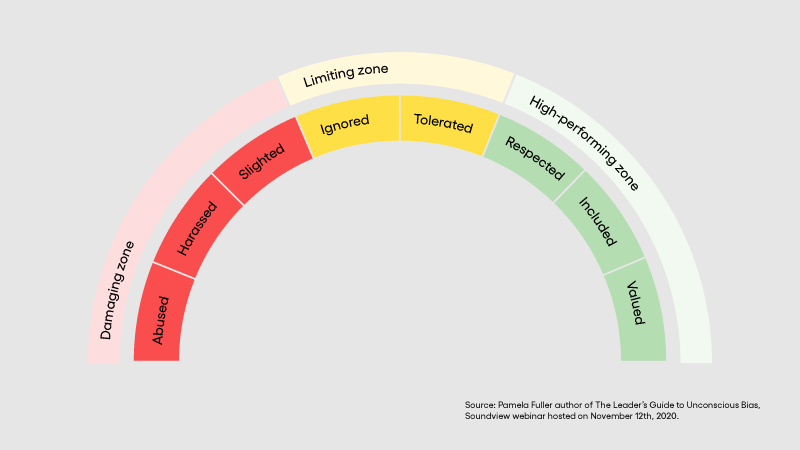
The exercise is rather simple: we place each member of our team in one of these three zones:
- Damaging zone
- Limiting zone
- High-Performance zone
At this point, let’s not think about why we put them in one zone or another, as those may differ from our biases.
The tolerance concept
As I completed this exercise, I focused on the word “tolerance”.
“Show openness and tolerance.”
“I am a very tolerant person.”
We hear these phrases often. In the media, in lunchtime conversations.
But listening to Pamela speak and doing the exercise myself, it hit me. In a professional context, when a leader is simply tolerant of diversity, there is something startling, unacceptable. Our decisions have an impact on performance, opportunities and ultimately on someone’s career. To tolerate someone is to narrow their opportunities of reaching their full potential.
Okay, I will now close my editorial parenthesis and move on to the second step after identification, connection.
Connecting
We have more technological tools in our hands than ever before, and yet, connecting with the humans who make up our team is not easy. We cannot claim to be a good leader without connecting with our team members, especially those in limiting or damaging zones.
Here are two tips from Pamela’s approach to improving connections.
First tip: focus on empathy and curiosity
Empathy is the search for an emotional connection. It is easy when we meet someone who looks like us, who has had experiences similar to ours.
But what about the people with whom we have little in common? Do we give them the same level of understanding and patience?
Concretely this means that if a member of our team arrives late for a meeting, will our reaction be the same, regardless of the zone in which we have placed them?
Curiosity, on the other hand, involves the search for an intellectual connection with the other. It’s when we put ourselves in an open state of mind, ready to make new connections (remember neuroplasticity). This is what happens when we realize that our personal experience is rich and unique, and is as rich as any other person’s experience.
The question to ask ourselves here is: Do I practice the same level of empathy and curiosity towards all my team members?
As a guide, let’s do the activity of the five-year plan. We probably have a more or less vague idea of where we see ourselves in five years.
What about our team members? Do you know what stresses them the most, what drives them the most in their work?
If we don’t know the answer to this question, how do we support our team in achieving their professional goals?
Second tip: Auditing our network
It’s hard to change our practices when those around us share similar views. Let’s start by identifying the people we ask for help or advice, those with whom we bounce ideas off. Are they always the same people?
It’s very likely.
What are the opportunities for us to expand our network? Does it go through volunteer involvement? Looking for a new mentor? Starting a new project that requires other expertise?
Sometimes it can also be as simple as analyzing the source of our information. Can you consume a new podcast this week? Join a new group on Facebook? Diversifying your sources of information also helps create new connections.
Choose courage
To choose courage is to take action. It starts with the first question you ask yourself. It continues when you become OK with the idea of relearning what you think you know about yourself. It is perpetuated by showing empathy and sincere curiosity in others, especially those with whom it is more sensitive, more difficult.
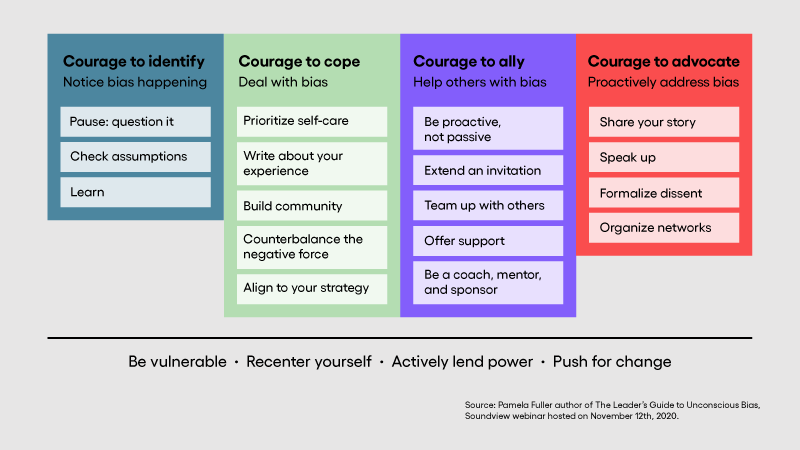
Courage is also taking a stand, questionning the process. Just because you’ve always hired in such a way doesn’t mean it’s the best way to hire.
Courage is also about being proactive, offering our support, coaching those who are not so far along in their journey. Courage is ultimately to become a defendant. To be a carrier of change. It involves sharing our history, naming the elephant in the room, and dissociate (or dissociating?) loudly and clearly from attitudes and behaviors that prevent employees from reaching their full potential.
Challenging our biases is as important as the impact they have on those around us. As an HR leader, this impact is enormous. It changes the course of a career, unveils new opportunities, or takes them away.
I will leave the final words to Pamela, because I haven’t been able to find ones that resonate as profoundly:
" There is no idea more fundamental to performance than how we see and treat each other as human beings. "
Pamela Fuller
To deepen the concepts covered in this article and unlock the full potential of your team, subscribe to one of Pamela Fuller’s upcoming webinars.


